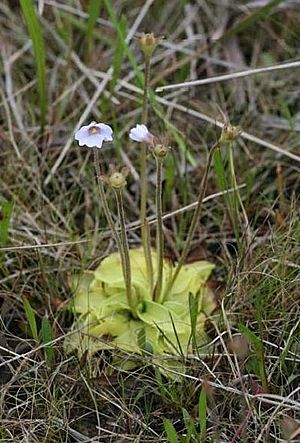Godfrey's butterwort facts for kids
Quick facts for kids Godfrey's butterwort |
|
|---|---|
 |
|
| Conservation status | |
| Scientific classification | |
| Genus: |
Pinguicula
|
| Species: |
ionantha
|
Pinguicula ionantha is a very rare and special flowering plant. It's often called Godfrey's butterwort or violet butterwort. This unique plant is a type of carnivorous plant, which means it catches and eats insects! It only grows naturally in the central Florida Panhandle in the United States. Because its home is disappearing, it is a federally protected species. This means it needs our help to survive.
Contents
About Godfrey's Butterwort
What This Plant Looks Like
This butterwort is a perennial herb. This means it lives for more than two years. It forms a flat group of bright green leaves. These leaves have edges that roll inward. Each leaf can grow up to 8 centimeters long. They are covered with tiny, sticky hairs. These hairs are like glue for insects.
How it Catches Food
Like other carnivorous plants, Pinguicula ionantha uses its sticky leaves to trap insects. When an insect lands on a leaf, it gets stuck. The plant then digests the insect. This helps the plant get important nutrients. It's like a natural bug trap!
Its Beautiful Flowers
The plant grows a tall stem called a scape. This stem can reach up to 15 centimeters high. Flowers appear from February to April. The flower is a pale violet color. It has a darker violet center. Sometimes, you can see darker purple lines inside. The flower is about 2 centimeters wide. It also has a small greenish spur at the back. In the middle of the flower is a yellow or red cone. This cone is covered in tiny hairs.
Where Godfrey's Butterwort Lives
This rare butterwort is found in only six counties in Florida. These areas are between Tallahassee and Panama City, Florida. It grows in wet areas called bogs. These bogs are often found in pine savanna habitats. The plant can live in deep bogs or shallower wet spots. It can even survive underwater for a few days after heavy rain.
Other plants that live here include pond cypress trees. Taller areas have longleaf pine trees. You might also see wiregrass and other unique plants.
Why Fire is Important Here
The habitat where this butterwort lives needs fire. Natural Wildfires help keep the area open and sunny. Without fire, larger trees and shrubs would grow. They would block the sunlight from reaching the smaller plants. This would make it hard for the butterwort to survive. When a fire happens, this rare plant often grows better.
Why it Needs Help
Godfrey's butterwort faces many threats. One big problem is habitat destruction. Its home is being cleared for different reasons.
- Logging: Forests are cut down for timber. Some areas become tree farms for paper.
- Development: Land is cleared for new buildings and towns.
- Roads: Some plants grow near roads. Road work can harm them. Sometimes, whole groups of plants disappear.
- Storms: In 2004, Hurricane Frances caused saltwater to flood one area. This hurt the plants.
- Past Overcollection: In the past, too many plants were taken by people. This made the plant even rarer.
Helping the Butterwort Survive
Today, efforts are being made to protect this special plant. Growing the plant in special nurseries helps. The International Carnivorous Plant Society even has permission to sell its seeds. This helps people learn about and appreciate this unique Florida native. Protecting its bog habitat and allowing natural fires are also very important steps.


